Top News

October 24, 2011 Ryukyu Shimpo
Six months have passed since the Great East Japan Earthquake, but at concert venues in the United Kingdom, various groups and individuals are continuing to raise money. Noriko Uchima, from Okinawa City, has been actively involved in fund-raising as one of the core members of “Kimono Girls,” a group fronted by the renowned saxophone player Meg from Minamisoma City in Fukushima Prefecture.
At “The Glastonbury Festival Of Contemporary Performing Arts,” the biggest open-air music festival in the United Kingdom, girls clad in kimono and yukata called for donations, attracting the attention of many people in the audience. The “Kimono Girls” expanded their fund-raising activities beyond concert venues and now hold charity bazaars and Japanese cultural workshops, and they plan to continue to provide ongoing support.
“Kimono Girls” are made up mostly of Japanese living in the United Kingdom and they currently have 117 members. Uchima leads a hectic life as an organizer of many projects that reach out to members of the Okinawa Kenjinkai and the London Sanshin Kai. To date, the total for donations is approximately 180000 pounds and this has been sent to the afflicted area through the Red Cross Society.
(English Translation by T&CT, Lima Tokumori and Mark Ealey)
Go To Japanese
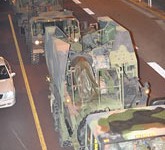
October 25, 2011
Early in the morning of October 25, the United States Army moved its PAC3 (Patriot surface-to-air missile) and related vehicles, which had been deployed in the U.S. Air Force Kadena Air Base to U.S. Marine Corps Futenma Air Station and Camp Courtney in Uruma City. The Okinawa Defense Bureau was notified of this by the U.S. military on October 24, and then informed the local police and municipal authorities. At around 12:20am on October 25, six vehicles loaded with equipment related to the PAC3 missile left Kadena Air Base Gate 1.
A PAC3 maneuvering drill was held during the Japan-U.S. joint exercises in early December last year in which convoys of about eight vehicles loaded with equipment related to the PAC3 repeated a moving drill every 30 minutes on National Route 58 between midnight and daybreak. According to the Ginowan municipal authorities, office staff of the Defense Bureau explained the maneuvering of the missiles at around 3:40pm on October 24, saying, “The U.S. Patriot missile battery will be deployed to the U.S. Marine Corps Futenma Air Station and Camp Courtney.”
According to the Kadena local authorities, they were told, “[PAC3 missile] will move on a deployment drill.” However, because “U.S. forces could not comment for security reasons”
the authorities were not given any information about the specific time and number of vehicles. Shigeo Yamauchi, director of the Base Policy Department for Ginowan City, said, “We were notified in advance, but were not given details of the time or the number of vehicles involved. We are not sure whether or not the move is temporary.” He continued indignantly, “We local residents live our lives amid the risks that Futenma Air Station brings. Even if it the deployment of the Patriot missiles is supposed to a temporary measure, it is not something that we are prepared to tolerate.”
(English Translation by T&CT, Mark Ealey)
Go To Japanese

Go To Video

October 22, 2011 Ryukyu Shimpo
On the evening of October 20 at the Tenbusu Theater in Naha, a performing arts group from Hawaii called Ukwanshin Kabudan gave a performance entitled Ichimadin Shimanchu, which in English means, “Forever Islanders.” The four Okinawans from Hawaii worked hard to convey the message: “What will be left of Okinawa if we lose its languages. Let’s use the Okinawan language.” They put their heart and soul into performing Okinawan folk songs and Hawaiian music so as “to maintain the spirit of Uchina.”
The large audience sang Okinawan folk songs with the performers and responded to the show with constant clapping, hayashi (chant), and whistling. The performance was full of a strong sense of unity.
The performers were third and fourth generation Okinawans from Hawaii – Eric Wada, Keith Nakaganeku, Norman Kaneshiro, and Brandon Ing.
Wada said, “We are always concerned about Okinawa. At the moment, the local language (Uchinaguchi) is in crisis. We love Okinawa. Please do your best to use Uchinaguchi expressions such as mensore (welcome) and nife debiru (thank you).”
(English Translation by T&CT, Megumi Chibana and Mark Ealey)
Go To Japanese
October 20, 2011 Ryukyu Shimpo
On October 19, Mayor of Naha Takeshi Onaga announced that the Worldwide Uchinanchu Festival was the stimulus behind the city making an effort to encourage people to give greetings in Uchinaguchi (Okinawan language) on formal occasions. At a regular press conference held in Naha City Hall, Mayor Onaga said, “To respond to the expectations of Uchinanchu living overseas, I hope that we can create an environment in which people use symbolic Uchinaguchi words, such as haisai (hello).”
The reason behind Mayor Onaga’s determined stance was that he read a newspaper article stating that a man in his 60s of Okinawan descent who participated to the festival was shocked to find out that Okinawans his age can no longer speak Uchinaguchi. He also said that he “feels a little sad” to think that there are officials in the City Hall who don’t understand any Uchinaguchi. He indicated the strength of his intention saying, “I wanted to convey my feelings while the matter was still fresh just after the end of the Uchinanchu Festival. I will talk to the Okinawa Association of City Mayors, and hope that the movement spreads through the prefecture.”
(English Translation by T&CT, Lima Tokumori and Mark Ealey)
Go To Japanese

October 20, 2011 Ryukyu Shimpo
The winners of the 59th Kikuchi Kan Prize (sponsored by the Society for the Promotion of Japanese Literature) were announced on October 19, with 87 year-old Toru Maeara being selected for publishing a Taketomi dialect dictionary (published by Nanzansha). Originally from Taketomi Island, Maeara now lives in Ishigaki City. Previous recipients from Okinawa are Ryoken Toyohira (1972), and the Himeyuri Peace Museum (1992).
After retiring from a career in teaching, Maeara documented the Taketomi dialect from his own memory, and from interviews with elderly people carried out over the past 27 years. In March 2011, he and a number of former students published this dictionary containing a total of 17700 words.
The Society for the Promotion of Japanese Literature rates the dictionary very highly, stating, “It makes an important contribution to our heritage, allowing us to study the history and folklore of both the Ryukyuan languages and Japanese.”
Maeara said, “These days, fluent speakers of the dialect hardly ever use it, so I started to record it out of concern for its rapid decline. I was able to complete the dictionary thanks to cooperation from former students and my publisher, but I never expected it to win such a prize.”
(English Translation by T&CT, Shinako Oyakawa and Mark Ealey)
Go To Japanese
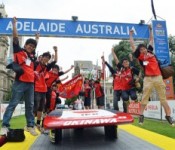
October 24, 2011 Sadaharu Shimabukuro of the Ryukyu Shimpo
On October 23, the final day of the 2011 World Solar Challenge – the world’s largest solar car race, about 3000 kilometers across Australia – Team Okinawa “Lequion” finished the race by crossing the finish-line in Adelaide. Team Okinawa was formed with students from public high schools centered on a core of young people from Okinawa Nanbu Technical High School. Students from local high schools came together like this to become the first Japanese public high school team to have a tilt at the World Solar Challenge. They travelled 2408 kilometers powered by the sun, and finished 13th out of 37 participating teams.
The teams started the race in Darwin in the north of Australia on October 16, covering a huge distance in the days that followed.
Only three teams actually crossed the finishing line, because the race was affected by a wildfire on the third day and by bad weather on the fourth and fifth days of the race, when overcast conditions blocked the sunlight required to supply fuel energy to the cars, so it was tough going for most of the teams.
On the sixth day, October 21, at a point 2386 kilometers from the start-line “Lequion” gave up on being self-propelled by sunlight. They finally arrived in Adelaide using a combination of transport by truck and self-propulsion using sunlight. However, they struggled to get among the higher places claimed by the likes of Cambridge University and the Massachusetts Institute of Technology.
(English Translation by T&CT, Mark Ealey)
Go To Japanese
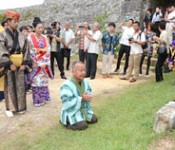
October 20, 2011 Ryota Shimabukuro of Ryukyu Shimpo
On October 1, the wedding of Naha residents Naoyuki and Kae (née Takemura) Matsuda was held at Zakimi Castle, which is a World Heritage Site. The couple and their parents dressed in Ryukyu Dynasty traditional costume and together with Mitsuo Higa, the head of Zakimi Ward, they went to a place of worship in the castle to announce their marriage. The bride and groom prayed for good health and wellbeing for themselves, their family and friends who had come to attend the ceremony. After the prayers, the guests celebrated the couple’s new start.
Naoyuki and Kae Matsuda are from Tokyo and Hokkaido, respectively. Both love Okinawa, and have worked here. They met through a mutual friend. When Kae worked at a hotel in Yomitan, they often visited Zakimi Castle to go on walks, so on the suggestion of mutual friend Takiro Kinjo, that is where they decided to hold their wedding.
In what is called a michijune, the newly-weds paraded down the street from Zakimi Castle to Shima-maruminu-kawaraya, a traditional Ryukyuan house located near the castle. The couple smiled when their friends told them, “You look like someone important,” and “How beautiful you are!” At Shima-maruminu-kawaraya local residents performed a Ryukyuan dance and played the sanshin for the happy couple.
Shinji Satake, who works at a kimono dressing shop that has organized a course for people to walk dressed in Ryukyuan traditional costume, helped to plan the marriage ceremony with Kinjo. He said, “I thought that there must be something that I can do taking advantage of the wonderful cultural assets of Zakimi Ward. In conjunction with local residents, in future I want to think about producing a resort wedding package at the World Heritage Site.”
(English Translation by T&CT, Lima Tokumori and Mark Ealey)
Go To Japanese
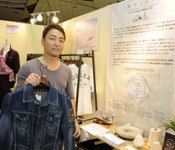
October 22, 2011 Ryukyu Shimpo
The 35th Annual Okinawa Industrial Festival opened on October 21 at the Okinawa Prefectural Budokan in Naha. The booths at the venue featured many typical and attractive Okinawan products, including new items with high-tech and innovative features. Cosmetics and kariyushi apparel designed to match the tastes of women and young people attracted the attention of visitors. In the business meetings held during the festival, local manufacturers worked hard to sell their products to buyers from Asian countries. The unprecedented number of exhibitors participating in the festival reflects the fact that a diverse range of individuals and groups are working on a variety of manufacturing projects in Okinawa.
Fashion House Madonna (President Mitsuko Yamauchi), which is working on the production of clothes using materials such as Okinawan weaved fabric and dyeing methods including bingata, exhibited jeans and T-shirts made of rayon fabric into which weathered coral powder has been kneaded. These products called “sea silk” have superior qualities in terms of warmth and elimination of odor, and also cut out ultraviolet rays. It took about 18 months to develop the product through a process of trial-and-error.
Currently, the company produces three items of jeans for men, one type of women’s jeans and is also developing some denim jackets. The jeans sell for 25000 yen under the brand name “DoSEA” in three shops in Naha, including Okinawa Mitsukoshi.
The sale of T-shirts will commence from this November and the denim fabric has been adopted for use by an established French luxury brand.
Kenji Yamauchi, the company’s creative director said, “These products are to be adopted by a spring-summer collection due to be unfurled in Paris. We would like to encourage the use of a fabric like this that utilizes the resources of Okinawa.” The company will use “sea silk” fabric in underwear and daily items in the future.
(English Translation by T&CT, Mark Ealey)
Go To Japanese
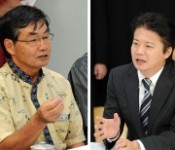
October 20, 2011 Ryukyu Shimpo
On October 19, Foreign Minister Koichiro Genba met with Nago Mayor Susumu Inamine at Nago City Hall, and with Okinawa Governor Hirokazu Nakaima at the Okinawa Prefectural Office. He requested their understanding with regard to the plan to relocate the Futenma Air Station to Henoko, Nago City, which was decided upon by the governments of the United States and Japan. However, the mayor responded by expressing his objection to the Henoko plan and strongly requested that both governments cancel the agreement regarding Henoko. Governor Nakaima reiterated his stance, saying, “[Getting acceptance of] moving the U.S. Marine Corps from Futenma Air Station to Henoko will take a long time. We want it moved somewhere else in Japan and want Futenma Air Station returned to Okinawa without further delay.” The central government is yet to bridge the rift between Tokyo and Okinawa.
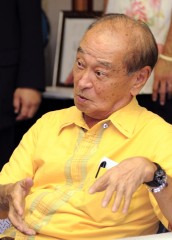
In the afternoon of October 19, at the Okinawa Prefectural Office Okinawa, Governor Hirokazu Nakaima asks the foreign minister to relocate Futenma Air Station outside of the prefecture.
At the meeting with Governor Nakaima, the Foreign Minister issued an apology, saying, “[With regard to the Futenma relocation] Our talk of relocation to somewhere ‘at least outside the prefecture,’ increased the level expectation, and unfortunately, we have ended up coming back to the Henoko plan.” He went on to say, “Considering the role of Okinawa in East Asia, finding an alternative somewhere else is no easy matter. It’s painful for me to have to say this, but I would like to ask you to accept the relocation of the facilities at Futenma within the prefecture. This is the starting point for us to remove the risks that currently surround Futenma. We want to move ahead with this plan in keeping with the U.S.- Japan agreement to promote the relocation of the Marine Corps in Okinawa to Guam and to return the land used by U.S. bases south of Kadena.” With this Genba indicated his intention to push ahead with the relocation to Henoko.
With regard to the matter of U.S. military personnel not being prosecuted despite being suspected of causing fatal traffic accidents while driving under the influence of alcohol, Foreign Minister Genba said, “I want to do something about this old agreement between Japan and the United States in which the consumption of alcohol by someone attending a public event has been treated as ‘being on official business.’ I will do my best to get something done about this.”
At his meeting with Nago Mayor Inamine, the foreign minister said, “[With regard to the relocation of Futenma outside the prefecture] I would like you to understand that we have tried hard to come up with a way to resolve this issue,” but the mayor responded by saying, “We do not sense that the government is trying hard to resolve this issue.” He continued by saying, “The candid opinion of the people of Okinawa is that we will not tolerate any further burden.” Inamine also explained his election promise that he “will not approve the construction of a new base in the sea or on the shore at Henoko,” and after clearly stating, “Right to the end, I am determined to keep the promise I made to the residents,” he urged the foreign minister to approach the United States to call off the plan to relocate the base to Henoko.
On October 19, Foreign Minister Genba visited Futenma Air Station and Camp Schwab. On the same day, he also met with Takeshi Onaga, the mayor of Naha City, Takeshi Gibu, the mayor of Kin Town, and with various leaders of the municipalities around Kadena Air Base.
(English Translation by T&CT, Mark Ealey)
Go To Japanese

Go To Video

October 18, 2011 Ryukyu Shimpo
On October 17, Defense Minister Yasuo Ichikawa met with Okinawa Governor Hirokazu Nakaima at the Okinawa Prefectural Office, and then with Nago City Mayor Susumu Inamine at Nago City Hall. At these meetings, he explained that before the end of this year he intends to submit a written evaluation to them on the environmental impact of the reclamation of the coastal area of Henoko, Nago City, which has been decided upon as the site for relocation of the United States Marine Corps Air Station (USMCAS) Futenma. This is the first time that the central government has officially conveyed this to Okinawa Prefectural Government. The Governor responded by saying, “I have made political commitments on this matter,” and asked that the Futenma Air Station be relocated outside the prefecture.
Chief Cabinet Secretary Osamu Fujimura held a press conference in Tokyo that same day, at which he also made it clear that the government intends to submit the evaluation report later this year.
The submission of this report means that the environmental assessment procedure, which has effectively been in a stalemate for almost two years, may move forward, and so in terms of procedural requirements at least, the plan to relocate the facilities at Futenma to Henoko will move ahead. However, at this point in time, Governor Nakaima’s stance of wanting the Futenma Air Station to be relocated outside the prefecture is unchanged, so the outlook for genuine progress on the relocation plan is not good.
In his meeting with the governor, Defense Minister Ichikawa said, “In June, both [the United States and Japanese] governments confirmed the location and configuration of the replacement facility for Futenma Air Station that was decided in the Japan-U.S. agreement. We are now getting ready to submit the evaluation report [on the environmental impact of the relocation] before the end of this year.”
Governor Nakaima responded by saying, “The situation surrounding the Futenma issue has changed considerably in the two years since then [ie. Since the submission of the preparatory documents representing the previous step in the evaluation report]. What is happening about the [deployment of] the Osprey aircraft?” “I have political commitments that I must adhere to. People’s anger is still unresolved. Please do not forget that the blame for this situation can be attributed in part to your Democratic Party.” With this the governor again demanded the relocation of Futenma outside the prefecture.
At a press conference before his return to Tokyo, with regard to the plan to deploy MV-22 Osprey vertical takeoff and landing transport aircraft to Futenma Air Station, a matter that was not included in the preparatory environmental impact assessment statement issued by the government, Ichikawa said, “[The United States Government] has indicated its intention to deploy these aircraft next year. We will cover this in the evaluation report. I want to be able to explain this properly.” The government will evaluate the effect of possible changes in the model of aircraft to be deployed, and Ichikawa indicated that the intention is to complete the assessment of the impact of deploying Osprey aircraft this December.
«Terminology related to the Environmental Impact Statement.»
In the case of large construction projects, the business operator (the central government) is required by law to investigate, predict and evaluate the environmental impact of related business procedures and to submit a report on this to the relevant prefectural and city governments as the final stage in the process. The governor must then return a written statement of opinion within 90 days of having received the evaluation report from the business operator. The central government then makes amendments based on that written statement of opinion, and with this, the evaluation assessment is complete. The central government can then apply for approval from the governor for the construction landfill.
(English Translation by T&CT, Mark Ealey)
Go To Japanese
October 14, 2011 Ryukyu Shimpo
On October 13 it was revealed that two days earlier, on October 11, in the No. 3 Small Courtroom, the Supreme Court (Presiding Judge Kohei Nasu) rejected the appeal from the plaintiffs in the suit against the government over the Futenma aviation roar issue in which residents of the area surrounding the United States Marine Corps Air Station (USMCAS) Futenma sought to halt flight activities during the night and early morning. This lawsuit over aircraft noise can be traced back to that lodged with the Court of Appeal In July 2010. Some 396 people living around the air station sought to secure an aviation flight ban and demanded compensation for damages from the government. The Court of Appeal decision confirmed the payment of twice the previous amount of compensation paid by the government in such cases, but rejected the request for a ban on night flying activities.
Ten of those residents who were dissatisfied with the ruling of the Court of Appeal responded by taking the case to the Supreme Court. With regard to the suspension of the appeal seeking a ban the flight activities from the residents, the Supreme Court explained the legal basis for turning down the appeal from the plaintiffs by saying, “Their stance is that there was a violation of the law due to factual error [in the Court of Appeal decision],” but this does not fulfill the necessary conditions for bringing the matter to the Supreme Court. In Article 312 of the Code of Civil Procedure the grounds for an appeal are stated as being that “the ruling is incorrect in its interpretation of the Constitution” or that it “contains violations of the Constitution.”
The plaintiffs’ lawyers stated, “While the judicial authorities confirm the presence of illegal noise pollution around the air station, they have done nothing to protect residents from the harm caused by this noise.” The lawyers also criticized the ruling of the Supreme Court, saying, “The appeal being dismissed without any flight ban is not a decision worthy of the Court of Appeal.”
(English Translation by T&CT, Mark Ealey)
Go To Japanese












 Webcam(Kokusai Street)
Webcam(Kokusai Street)


